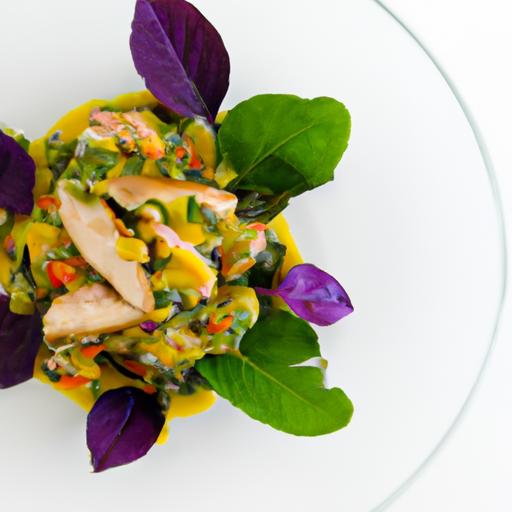In the world of cooking, the secret to unforgettable dishes often lies not just in the ingredients themselves, but in how they are introduced to the heat. Enter the age-old debate of blooming spices versus dry adding-a subtle technique that can transform ordinary meals into aromatic masterpieces or leave them flat and one-dimensional. Unlocking these flavor secrets means understanding the alchemy at play when spices meet oil or dry heat, setting the stage for layers of complexity, depth, and an irresistible fragrance. Join us as we explore these culinary methods, revealing how each approach unlocks the full potential of spices and elevates your cooking from simple to sublime.
Blooming Spices vs Dry Adding: Unlocking Flavor Secrets is a culinary principle that transforms ordinary dishes into unforgettable flavor experiences. Understanding how spices interact with heat unlocks their full aromatic potential, allowing you to craft meals that are both fragrant and nuanced. By mastering the delicate dance between blooming spices and dry adding techniques, you elevate your cooking to an art form where each bite tells a story infused with warmth, depth, and intrigue.
Prep and Cook Time
- Preparation: 10 minutes
- Cooking: 15 minutes
- Total: 25 minutes
Yield
Serves 4 as a main dish flavor base.
Difficulty Level
Medium
Ingredients
- 2 tbsp whole cumin seeds
- 1 tbsp mustard seeds
- 1 tbsp coriander powder
- 1 tsp smoked paprika
- 1 tsp turmeric powder
- 2 tbsp ghee or neutral oil (e.g., sunflower oil)
- ½ tsp freshly ground black pepper
- 1 tsp dried chili flakes (optional)
- 2 garlic cloves, minced
- 1 medium onion, finely chopped
Instructions
- Heat the ghee or oil in a heavy-bottomed skillet over medium heat. Once shimmering, add the whole cumin and mustard seeds.
- Sauté the seeds gently until they begin to pop and release their aroma, about 1-2 minutes. Stir continuously to prevent burning.
- Add the minced garlic and chopped onions, cooking until translucent and fragrant, approximately 5 minutes.
- Sprinkle the coriander powder, turmeric, and smoked paprika over the sautéed mixture, stirring to bloom the spices evenly in the hot fat. Cook for 1-2 minutes to fully release essential oils; this transforms the spices into vibrant flavor powerhouses.
- Gradually add black pepper and chili flakes as a dry addition towards the end of blooming. This layering adds subtlety and complexity without overpowering the tongue with sharp spice.
- Adjust flame to low and let the spices meld with the onions, stirring occasionally for an additional 2 minutes. This step balances blooming and dry adding for an immersive depth of flavor.
- Remove from heat and use immediately as a flavorful base for dals, vegetables, or grain dishes.
Tips for Success
- Bloom spices over moderate heat to avoid burning and bitterness; patience brings out sweet nuances.
- For dry adding, toss ground spices onto the dish near the end of cooking to preserve delicate aromas and subtle heat.
- Customize your spice bloom depending on the cuisine: heavier oil usage for Indian dishes vs lighter for Mediterranean fare.
- Storing freshly bloomed spice bases in airtight containers can save prep time and deepen flavor in future meals.
Serving Suggestions
Use this intensely aromatic spice blend as the cornerstone of your curries, stews, or roasted vegetables. Garnish dishes with a sprinkle of fresh cilantro, a few toasted cumin seeds, or a drizzle of cooling yogurt to contrast the warm, layered spices. Pair with lightly cooked greens or a fragrant basmati rice pilaf to fully savor the interplay between blooming spices and dry additions.
| Nutrition (per serving) | Calories | Protein | Carbs | Fat |
|---|---|---|---|---|
| Blooming Spice Base | 120 kcal | 2g | 5g | 10g |

For those eager to deepen their knowledge, visit Serious Eats: The Science of Spices, an authoritative resource on spice chemistry. Also, check out our guide on layering spices for advanced flavor crafting techniques that synergize perfectly with these methods.
Q&A
Q&A: Blooming Spices vs Dry Adding – Unlocking Flavor Secrets
Q1: What does “blooming spices” mean in cooking?
A: Blooming spices is the art of briefly frying spices in hot oil or butter at the start of cooking. This technique “wakes up” the essential oils, intensifying their aroma and flavor before they mingle with other ingredients. It’s like giving your spices a flavorful passport to fully travel through your dish.
Q2: How is blooming different from simply adding dry spices?
A: When you add dry spices directly to a dish, they slowly release flavor as the food cooks, but often in a muted or gradual way. Blooming, on the other hand, activates spices upfront, unlocking their vibrant, intense notes quickly. It’s a flavor boost versus a slow simmer of taste.
Q3: Which spices benefit most from blooming?
A: Warm, fragrant spices-think cumin seeds, mustard seeds, coriander, cardamom, cinnamon sticks, and whole cloves-love blooming. Their essential oils pop when briefly toasted in fat, releasing layers of complexity that dry adding just can’t match.
Q4: Are powdered spices better dry added or bloomed?
A: Powdered spices can be gently bloomed too, but it requires care to avoid burning and bitterness. Usually, a quick stir into hot oil for a few seconds is enough to amplify their fragrance. However, delicate ground spices like paprika or turmeric might better suit later addition to preserve subtle nuances.
Q5: Can blooming spices change a dish’s flavor profile?
A: Absolutely! Blooming can deepen savory notes, add smoky or nutty undertones, and transform simple dishes into aromatic marvels. It’s the secret behind many beloved curries, stews, and sauces that pop with layered tastes.
Q6: Is blooming spices a cooking step used worldwide?
A: Yes! From Indian tadkas to North African harissa bases and Southeast Asian stir-fries, the concept of blooming spices in hot fat transcends cultures. It’s a universal key to unlocking the soul of spice.
Q7: Any tips for mastering the blooming technique?
A: Use moderate heat to avoid burning; watch closely as spices toast quickly; and choose a neutral oil or butter to carry the flavors. Once you see a pop, sizzle, or fragrant aroma, you’re on the right track. Then swiftly add other ingredients to soak up that fragrant essence.
Unlocking the flavor secrets of blooming vs dry adding spices is about embracing a small technique with a big payoff-transforming your cooking from ordinary to extraordinary through the magic of awakened spices.
In Summary
In the grand culinary symphony, spices are the notes that transform a simple dish into a memorable masterpiece. Whether you’re gently blooming your spices to unlock their aromatic oils or sprinkling them dry to maintain their bold, direct punch, understanding these techniques opens the door to a world of flavor possibilities. By mastering when and how to introduce your spices, you not only enhance your cooking but also embark on a flavorful journey that elevates every meal. So next time you reach for those fragrant seeds or vibrant powders, remember: the secret to unlocking their full potential lies in the artful dance between blooming and dry adding. Embrace this balance, and let your kitchen become a stage where spices truly shine.


